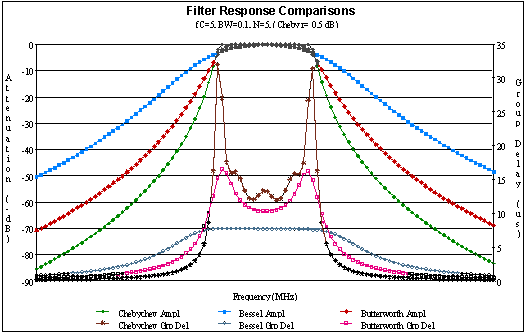Filter Transfer Functions |
||||||||||||||||||
|
An infinite number of filter transfer functions exist. A handful are commonly used as a starting point due to certain characteristics. The table following the plots lists properties of the filter types shown below. Not given - due to complex numerical methods required - are the Cauer (Elliptical) filters that exhibit equiripple characteristic in both the passband and the stopband. Phase information may be gleaned from the transfer functions by separating them in to real and imaginary parts and then using the relationship: Phase: θ = tan-1 (Im / Re) Group delay is defined as the negative of the first derivative of the phase with respect to frequency, or Group Delay:
by Robert J. Wenzel This CD-ROM course contains approximately 12-hours of instruction on the fundamentals of microwave filters, couplers and matching networks. Included is a thorough review of the common types of filter responses and calculations, filter realization, and various methods of filter design, including bandpass, network theory and Kuroda. Subsequent sessions cover the fundamentals of directional couplers. A final session describes distributed element matching networks and a matching network design example. Related Pages on RF Cafe - Butterworth Lowpass Filter Gain, Phase, and Group Delay Equations - Butterworth Highpass, Bandpass, & Bandstop Filter Gain, Phase, and Group Delay Equations - How to Use Filter Equations in a Spreadsheet - Filter Equivalent Noise Bandwidth - Filter Prototype Denormalization - Bessel Filter Prototype Element Values - Butterworth Lowpass Filter Poles - Butterworth Filter Prototype Element Values - Chebyshev Lowpass Filter Poles - Chebyshev Filter Prototype Element Values - Monolithic Ceramic Block Combline Bandpass Filters Design - Coupled Microstrip Filters: Simple Methodologies for Improved Characteristics |
||||||||||||||||||






